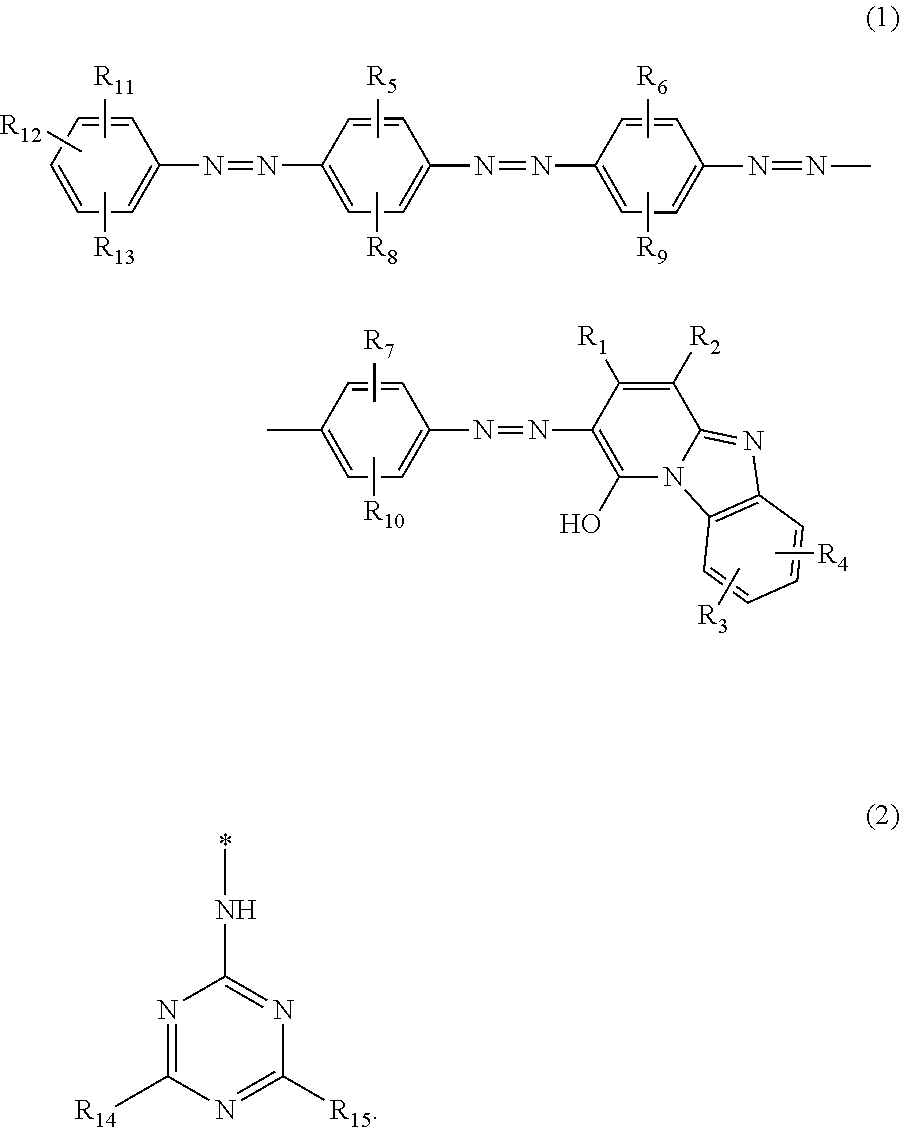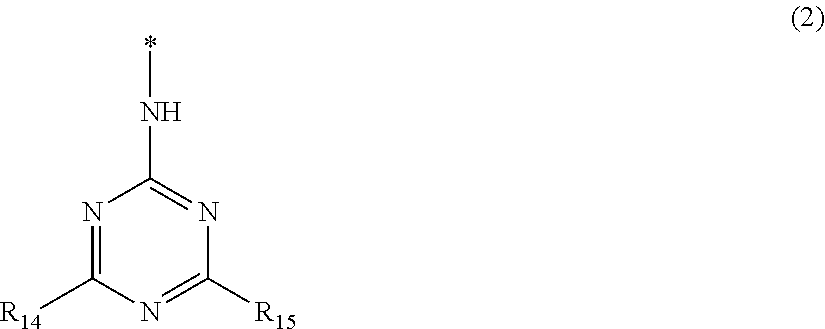Azo compound, ink composition, ink jet recording method, and colored article
a technology of ink jet recording and compound, which is applied in the direction of inks, duplicating/marking methods, polyazo dyes, etc., can solve the problems of glare on the surface of record-receiving materials, poor luster, and bronzing phenomenon, and achieve excellent light resistance, excellent moisture resistance, and high storage stability.
- Summary
- Abstract
- Description
- Claims
- Application Information
AI Technical Summary
Benefits of technology
Problems solved by technology
Method used
Image
Examples
example 1
(Step 1)
[0188]18.4 parts of cyanuric chloride and 0.1 parts of trade name: LEOCOL TD-50 were added to 200 parts of ice water, followed by stirring at 10° C. or less for 30 minutes. Then, 31.7 parts of 2,5-disulfoaniline (a commercially available 88.4%-pure product was used) was added thereto, followed by reaction at 0° C. to 10° C. for 2 hours with the pH being adjusted to pH 2.8 to 3.0 with the use of a 10% aqueous solution of sodium hydroxide and then at 25° C. to 30° C. for 1 hour with the pH being adjusted to pH 2.8 to 3.0. To the resulting reaction liquid, 16.9 parts of 4-chloro-3-nitroaniline was added, followed by reaction at 40° C. to 45° C. for 2 hours with the pH being adjusted to pH 5.0 to 5.5 with the use of a 10% aqueous solution of sodium hydroxide. To the resulting reaction liquid, 18.8 parts of 2-aminoethanesulfonic acid was added, followed by reaction at 70° C. to 80° C. for 3 hours with the pH being adjusted to pH 7.0 to 7.5 with the use of a 10% aqueous solution o...
example 2
(Step 7)
[0206]29.5 parts of the wet cake of the compound represented by the formula (29) and obtained in Example 1 (Step 6) described above was added to 80 parts of water, and the compound was dissolved by stirring. 6.3 parts of 35% hydrochloric acid was added thereto, subsequently 2.3 parts of a 40% aqueous solution of sodium nitrite was added thereto, and the mixture was stirred for about 30 minutes. To this, 0.5 parts of sulfamic acid was added, the mixture was stirred for 5 minutes, and thus a diazo reaction liquid was obtained.
[0207]On the other hand, 4.0 parts of a compound represented by the following formula (32) and obtained by a method described in PCT International Publication No. WO2012 / 081640 was added to 80 parts of water, and a 5% aqueous solution of sodium hydroxide was added thereto to adjust the mixture to pH 6.0 to 7.0. Thus, an aqueous solution was obtained. To this aqueous solution, the diazo reaction liquid obtained as described above was added dropwise over ab...
example 3
(Step 1)
[0209]18.4 parts of cyanuric chloride and 0.1 parts of trade name: LEOCOL TD-50 were added to 200 parts of ice water, followed by stirring at 10° C. or less for 30 minutes. Then, 31.7 parts of 2,5-disulfoaniline (a commercially available 88.4%-pure product was used) was added thereto, followed by reaction at 0° C. to 10° C. for 2 hours with the pH being adjusted to pH 2.8 to 3.0 with the use of a 10% aqueous solution of sodium hydroxide and then at 25° C. to 30° C. for 1 hour with the pH being adjusted to pH 2.8 to 3.0. To the resulting reaction liquid, 16.9 parts of 4-chloro-3-nitroaniline was added, followed by reaction at 40° C. to 45° C. for 2 hours with the pH being adjusted to pH 5.0 to 5.5 with the use of a 10% aqueous solution of sodium hydroxide. To the resulting reaction liquid, 19.6 parts of sodium 3-mercaptopropanesulfonate was added, followed by reaction at 70° C. to 80° C. for 3 hours with the pH being adjusted to pH 7.0 to 7.5 with the use of a 10% aqueous sol...
PUM
| Property | Measurement | Unit |
|---|---|---|
| temperature | aaaaa | aaaaa |
| temperature | aaaaa | aaaaa |
| pH | aaaaa | aaaaa |
Abstract
Description
Claims
Application Information
 Login to View More
Login to View More - R&D
- Intellectual Property
- Life Sciences
- Materials
- Tech Scout
- Unparalleled Data Quality
- Higher Quality Content
- 60% Fewer Hallucinations
Browse by: Latest US Patents, China's latest patents, Technical Efficacy Thesaurus, Application Domain, Technology Topic, Popular Technical Reports.
© 2025 PatSnap. All rights reserved.Legal|Privacy policy|Modern Slavery Act Transparency Statement|Sitemap|About US| Contact US: help@patsnap.com



